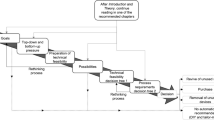Abstract
The overall goal of a clinical laboratory is to analyse samples of blood and other bodily fluids received from a patient, and to return the correct results to the patient’s doctor within a suitable period. Automated analysers are used in most laboratories to analyse the various samples. Computer systems (LIMS1) are widely used in laboratories to control, support and monitor the work done in the laboratory, keeping pace with the increased analytical capability provided by these analysers. In particular, a LIMS is typically used to control and monitor (at least):
-
the working of the analysers, deciding what tests need to be done for each sample by each analyser,
-
the collating of requests and results, and
-
the printing of the results.
Access this chapter
Tax calculation will be finalised at checkout
Purchases are for personal use only
Preview
Unable to display preview. Download preview PDF.
Similar content being viewed by others
References
Ministry of Defence. The Procurement of Safety Critical Software in Defence Systems. Interim Defence Standard 00-55. April, 1991.
Ministry of Defence. Hazard Analysis and Safety Classification of the Computer and Programmable Electronic System Elements of Defence Equipment. Interim Defence Standard 00-56. April, 1991.
The RAISE Language Group. The RAISE Specification Language. The BCS Practitioner Series. Prentice Hall, London, 1992
Fink R, et al: Data Management in Clinical Laboratory Information Systems. In: Directions in Safety Critical Systems. Redmill F and Anderson T (eds). Springer-Verlag, 1993.
Author information
Authors and Affiliations
Editor information
Editors and Affiliations
Rights and permissions
Copyright information
© 1993 Springer-Verlag London Limited
About this paper
Cite this paper
Collinson, P., Oppert, S., Hughes, S. (1993). The Application of Formal Methods for the Redevelopment of a Laboratory Information Management System. In: Górski, J. (eds) SAFECOMP ’93. SAFECOMP 1993. Springer, London. https://doi.org/10.1007/978-1-4471-2061-2_5
Download citation
DOI: https://doi.org/10.1007/978-1-4471-2061-2_5
Published:
Publisher Name: Springer, London
Print ISBN: 978-3-540-19838-3
Online ISBN: 978-1-4471-2061-2
eBook Packages: Springer Book Archive




